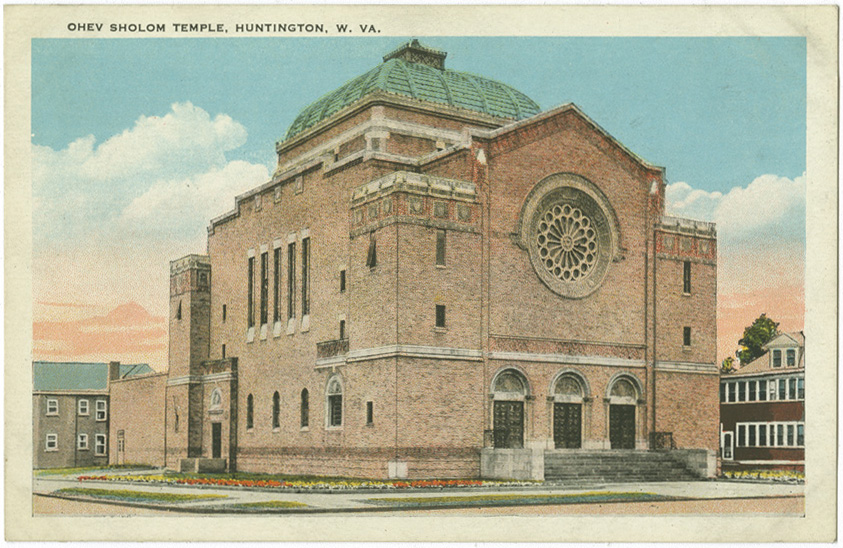8.3 Huntington, West Virginia
Ohev Sholom Temple, 10th Avenue and 10th Street
Meanor and Handloser, architects, 1925
Publisher and Publication date unknown, but postmarked August 30, 1908
This postcard depicts one of the largest synagogues in West Virginia, and the only one listed on the National Register of Historic Places. Impressive and eclectic, Ohev Sholom (Lovers of Peace) was designed by the Charleston, West Virginia, architectural firm of Meanor and Handloser. It draws on several forms popular for early 20th-century synagogues.
The building’s massing is like that of many other Byzantine Revival synagogues built in the 1920s. The three arched entryways of the facade recall both Byzantine and Romanesque church architecture, as does the large rose window in the center of the facade. The two blocky flanking towers, however, are reminders of an earlier tower tradition. Here, where the towers are used as stairways, they recall other examples such as Memphis, Tennessee; Mobile, Alabama; and Jacksonville, Florida, to name just a few.
The square dome had plenty of precedents in synagogues, for example, the great Tempio Israelitico in Rome, Italy. But a closer source would have been Temple Rodef Shalom in Pittsburgh, Pennsylvania.
The congregation had previously occupied a large Gothic structure, dedicated in 1892, which had two unequal facade towers and polychromatic decoration in brick and stone in the popular Ruskinian Gothic style. A site for a new building was purchased in 1919 at 10th Avenue and10th Street, and the edifice was dedicated in 1925.
Huntington also was home to a strong Orthodox community, which gradually transitioned into an active Conservative congregation, B’nai Israel. B’nai Israel’s synagogue, erected at the same time as Ohev Sholom’s—it opened in 1924—remained in use until 1978. It is now a church. Like Ohev Sholom, the style incorporates Byzantine and Romanesque motifs. The corner towers are taller in relation to the rest of the facade, and they frame a triple-arched entry to the building.
When Reform Ohev Sholom merged with the Conservative B’nai Israel in 1974, the congregation took the name B’nai Sholom. Services were held at both synagogues for a few years before all activity shifted to Ohev Sholom’s 1925 building, which was extensively renovated in 2003.
